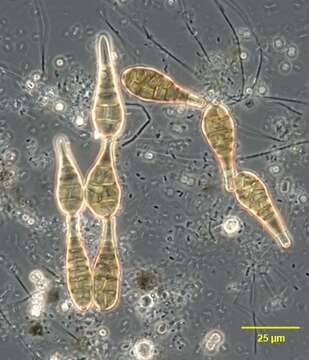Conidia

Description:
Conidia (spores) of the deuteromycotan fungus, Alternaria alternata (FRIES,1832) KEISSLER,1912. The conidia are obclavate (shaped like a bowling pin) and form single file chains as seen here. The spores have both longitudinal and horizontal septae. Each conidium tapers into a narrow rounded protuberance. Alternaria digests cellulose and is commonly found on dead grasses. Some species are plant pathogens causing "early" potato and tomato blight and leaf rot. The Irish potato famine of 1845-1849 was due to inection by a different fungus, Phytophthora infestans which causes "late" blight.These specimens of A. alternata were found at the margins of a slow-moving freshwater stream in Boise, Idaho.Since A. alternata is terrestrial and not aquatic, the water was probably contaminated by airborne conidia.Phase contrast.
Included On The Following Pages:
- Life (creatures)
- Cellular (cellular organisms)
- Eukaryota (eukaryotes)
- Opisthokonta (opisthokonts)
- Nucletmycea
- Fungi (mushrooms, lichens, molds, yeasts and relatives)
- Dikarya
- Ascomycota (sac fungi)
- Dothideomycetes
- Pleosporales
- Pleosporaceae
- Alternaria
- Alternaria alternata
This image is not featured in any collections.
Source Information
- license
- cc-by-nc
- author
- William Bourland
- provider
- micro*scope
- original
- original media file
- visit source
- partner site
- micro*scope
- ID


